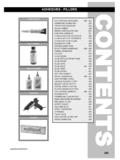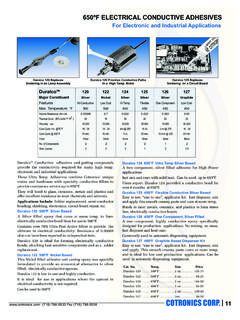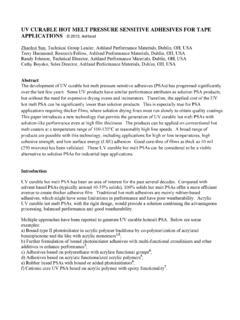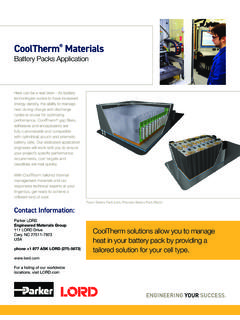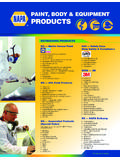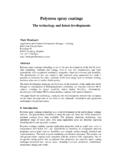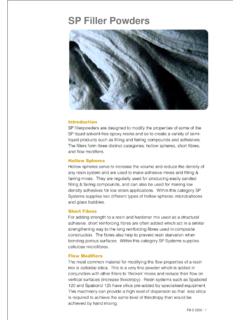Transcription of Understanding the use of Polyvinyl Acetate (PVA) …
1 Mekatronics, Inc., 85 Channel Drive, Port Washington, NY 11050 Tel: 516-883-6805 Fax: 516-883-6948 Affiliated Companies: Bendror International, Ltd., Oversewing Machine Company of America, Advanced Binding Methods, Inc. Understanding the use of Polyvinyl Acetate (PVA) Adhesives in Bookbinding By Jack Bendror For more than 40 years MEKATRONICS has designed innovative, reliable equipment to help the labor-intensive library bindery industry streamline their operations, reduce costs -- and still maintain quality.
2 Library binding is a separate and distinct industry in the bookbinding segment of the graphic arts. In contrast with edition binding where multiple copies of the same size book blocks are being processed, library binders bind book blocks in single copies of randomly intermixed sizes. The principal mission of the library binding industry since its emergence early in this century has been to extend the useful life of library books and periodicals by maintaining rigorous technical standards that emphasize careful performance of all procedures and the use of high quality materials.
3 Our introduction of the Ehlermann equipment to the library binding industry made it important that we acquire as much information as possible on the PVA emulsion adhesives that play a major role in that process. Most people find modern adhesive technology difficult to understand. This is understandable because the average binder: a. Is not a chemist or is too small to afford the services of one. b. Is not familiar with the terms used in modern adhesive technology so that he or she: c. Must rely on the adhesive supplier to provide her or him with a product suitable for the particular bindery operation.
4 This presentation is an attempt to provide some guidelines concerning properties and characteristics desired in a particular adhesive for a demanding binding operation. Efforts were made to make this presentation as non-technical as possible. Since the use of certain adhesive terminology could not be avoided, a Definition of Terms list compiled from information from the American Society for Testing Materials (ASTM) and from the Handbook of Adhesives by Irving Skeist has been provided.
5 In the late 60 s, along with the Ehlermann machines, we also introduced the LB-Super and LB Rapid 300N recommended for the various Ehlermann machines. Not only did we rely on our supplier s data regarding the performance characteristics of the adhesive, but we also made independent investigations. In particular, we questioned the need to import an adhesive when the technology for producing it existed in the United States. The following facts will shed some light on this complex subject. Mekatronics, Inc.
6 , 85 Channel Drive, Port Washington, NY 11050 Tel: 516-883-6805 Fax: 516-883-6948 Affiliated Companies: Bendror International, Ltd., Oversewing Machine Company of America, Advanced Binding Methods, Inc. 2 Historical Background The vinyl Acetate monomer was first invented in Germany in 1912. Real commercial development began in Germany in 1925. Commercial polymerization was in progress by 1929. In the 1930 s Emil Lumbeck pioneered the Double-Fan principle of leaf attachment known throughout Europe as the Lumbeck System.
7 What made the process unique was the combination of double fanning with the use of specially formulated Polyvinyl Acetate emulsions that demonstrated exceptionally good stability. Hans Ehlermann, Lumbeck s son-in-law, advanced the development of the Double-Fan binding machines and the European binders adopted the process as the primary method of leaf attachment. Although available in the United States and Canada since the 1930 s, Polyvinyl Acetate emulsions were not introduced commercially until the 1940 s during World War II as a synthetic resin substitute for animal-hide glue, then in short supply.
8 For these reasons, it made sense that we should take advantage of the vast knowledge and experience of the German suppliers of PVA emulsions. Following the sale of the Ehlermann company in 1987 and the ensuing uncertainty of maintaining an uninterrupted source of supply, we began a search of the European market for a quality adhesive that would equal or exceed the performance characteristics of the Ehlermann adhesives which we had been supplying for over 25 years. After visiting many European library binders, we found Eukalin to be a highly respected supplier of adhesive products.
9 Eukalin, established in 1904, had a reputation for producing a quality product consistently from batch to batch over many years. While performance is very important in the selection of an adhesive, secondary considerations such as manner and type of application are often very important in the selection process. The experience acquired as distributors of the Ehlermann machines was reflected in the formulation of the line of ULTRAFLEXTM adhesives. Independent laboratory tests on the ULTRAFLEXTM 4056 for example, revealed to our greatest satisfaction that ULTRAFLEXTM 4056 was 86% stronger than its predecessor LB-Super.
10 After its being in use by library binders in North America for over 25 years, it was the opinion of experts in the library community that copolymers were the safest, most conservative choice for bindings that need to perform for extended service lives (as much as 300 years, the life of alkaline paper) than homopolymers. To answer the question whether an externally plasticized homopolymer or an internally plasticized copolymer PVAc emulsion should be used for adhesive binding, the following facts must be considered: Mekatronics, Inc.
